Featured publications
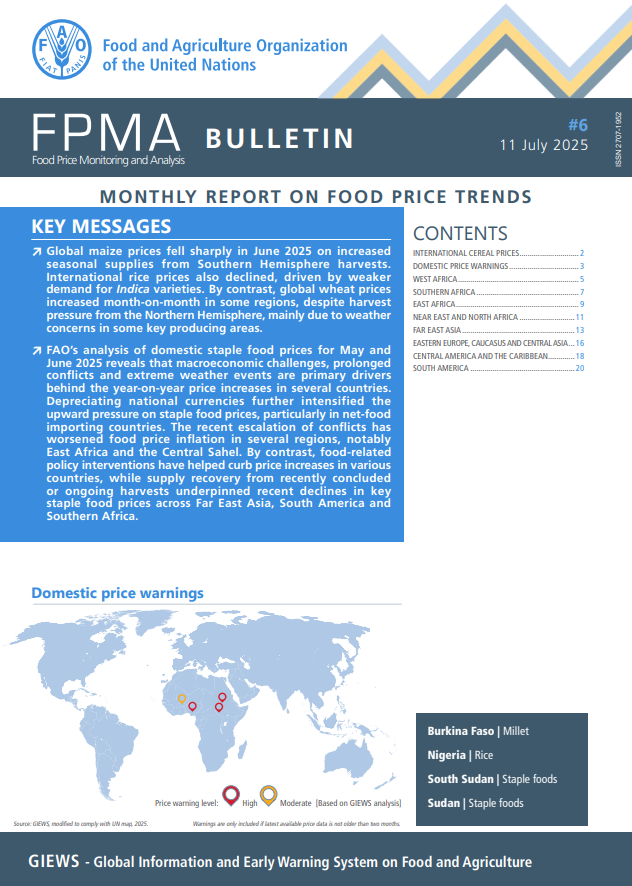
Journal; magazine; bulletin
Food Price Monitoring and Analysis (FPMA) Bulletin #6, 11 July 2025 - Monthly report on food price trends
11/07/2025
Global maize prices fell sharply in June 2025 on increased seasonal supplies from Southern Hemisphere harvests. International rice prices also declined,...
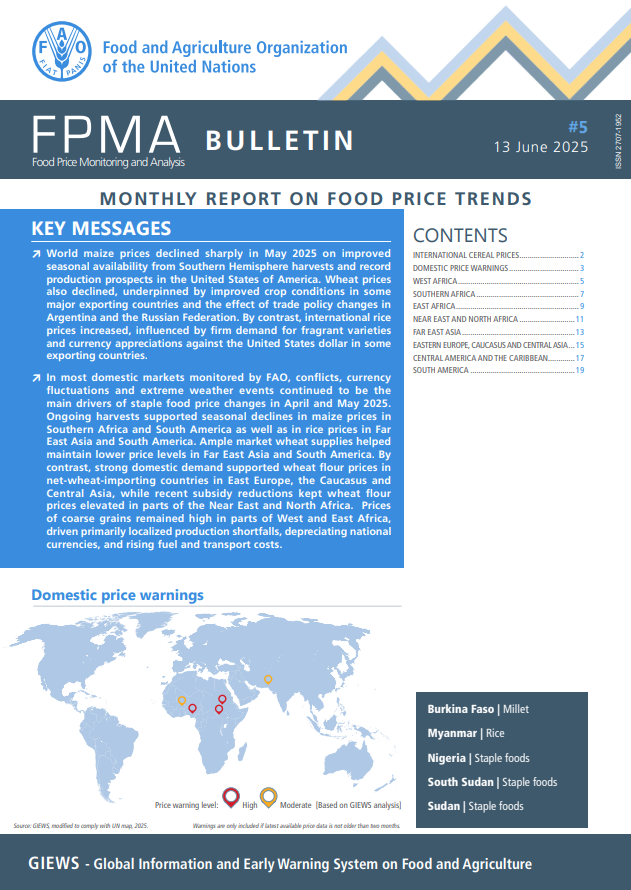
Journal; magazine; bulletin
Food Price Monitoring and Analysis (FPMA) Bulletin #5, 13 June 2025 - Monthly report on food price trends
13/06/2025
World maize prices declined sharply in May 2025 on improved seasonal availability from Southern Hemisphere harvests and record production prospects...
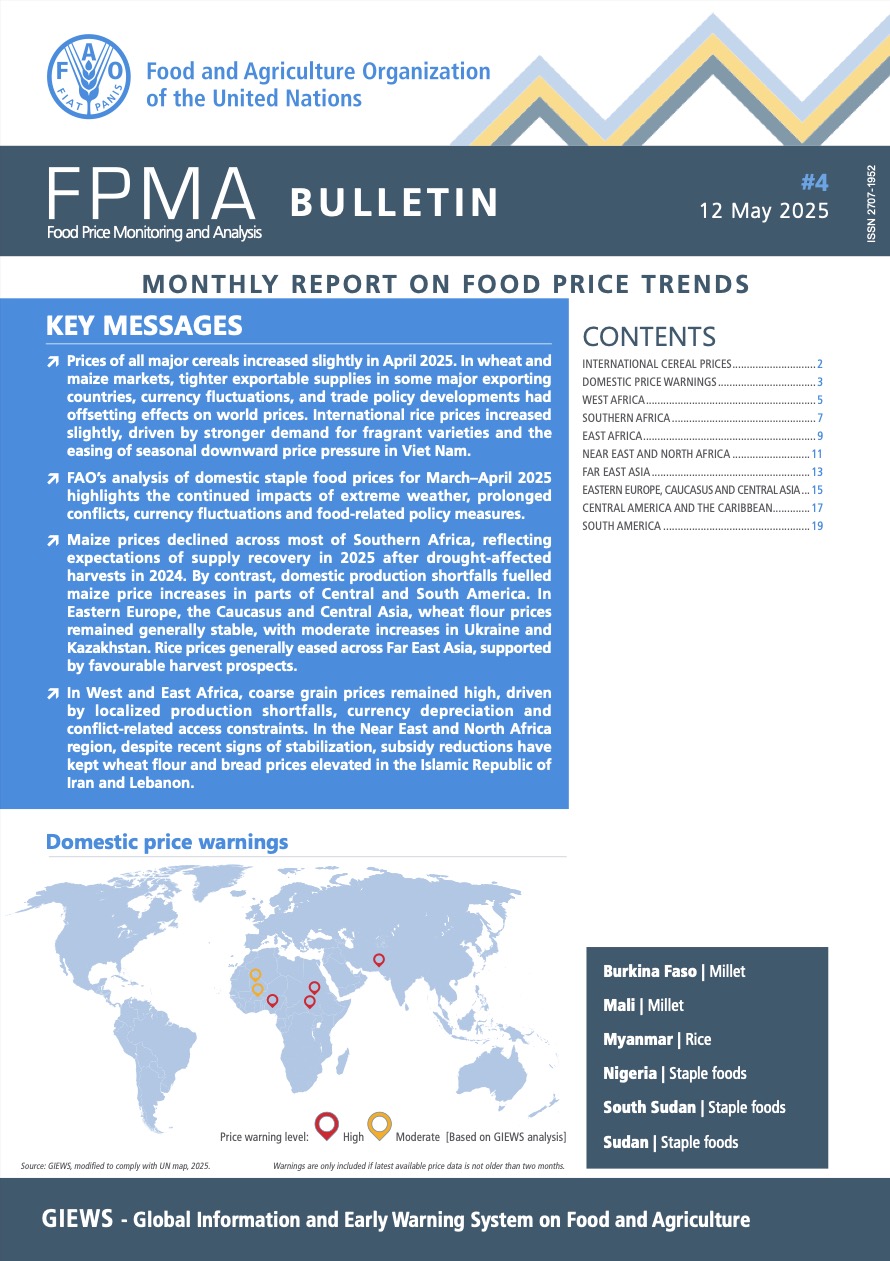
Journal; magazine; bulletin
Food Price Monitoring and Analysis (FPMA) Bulletin #4, 12 May 2025 - Monthly report on food price trends
12/05/2025
Prices of all major cereals increased slightly in April 2025. Tighter exportable surpluses in some major exporters, currency movements and trade policy...
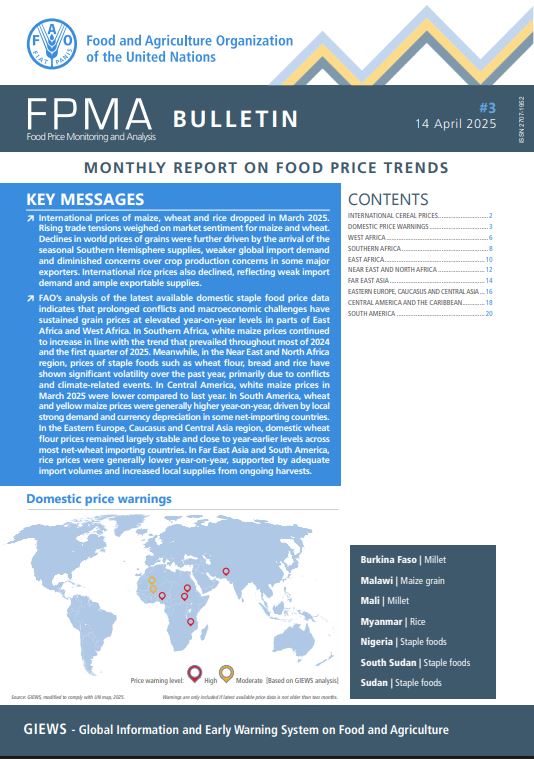
Journal; magazine; bulletin
Food Price Monitoring and Analysis (FPMA) Bulletin #3, 14 April 2025 - Monthly report on food price trends
14/04/2025
International prices of maize, wheat and rice dropped in March 2025. Rising trade tensions weighed on market sentiment for maize and wheat. Declines...
Publications
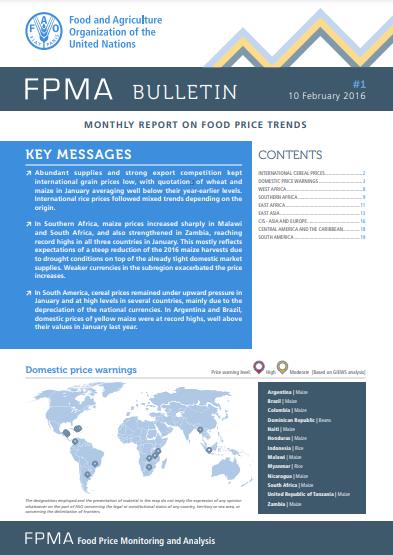
Food Price Monitoring and Analysis (FPMA) Bulletin #1, 10 February 2016
10/02/2016
Abundant supplies and strong export competition kept international grain prices low, with quotations of wheat and maize in January averaging well below their year-earlier levels. International rice prices followed mixed trends depending on the origin. In Southern Africa, maize prices increased sharply in Malawi and South Africa, and also strengthened in Zambia, reaching record highs in all three countries in January. This mostly reflects expectations of a steep reduction of the 2016 maize harvests due to drought conditions on top of the already tight domestic market supplies. Weaker currencies in the subregion exacerbated the price increases. In South America, cereal prices remained under upward pressure in January and at high levels in several countries, mainly due to the depreciation of the national currencies. In Argentina and Brazil, domestic prices of yellow maize were at record highs, well above their values in January last year.
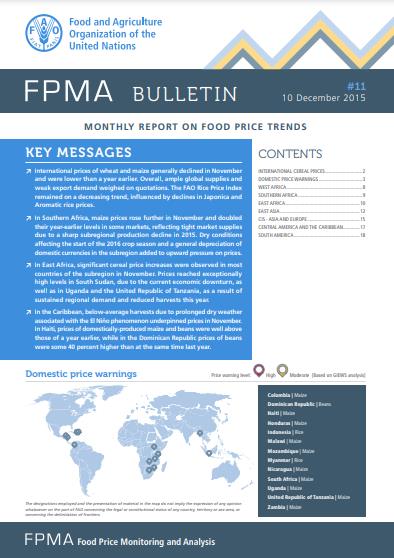
Food Price Monitoring and Analysis (FPMA) Bulletin #11, 10 December 2015
10/12/2015
International prices of wheat and maize generally declined in November and were lower than a year earlier. Overall, ample global supplies and weak export demand weighed on quotations. The FAO Rice Price Index remained on a decreasing trend, influenced by declines in Japonica and Aromatic rice prices. In Southern Africa, maize prices rose further in November and doubled their year-earlier levels in some markets, reflecting tight market supplies due to a sharp subregional production decline in 2015. Dry conditions affecting the start of the 2016 crop season and a general depreciation of domestic currencies in the subregion added to upward pressure on prices. In East Africa, significant cereal price increases were observed in most countries of the subregion in November. Prices reached exceptionally high levels in South Sudan, due to the current economic downturn, as well as in Uganda and the United Republic of Tanzania, as a result of sustained regional demand and reduced harvests this year. In the Caribbean, below-average harvests due to prolonged dry weather associated with the El Niño phenomenon underpinned prices in November. In Haiti, prices of domestically-produced maize and beans were well above those of a year earlier, while in the Dominican Republic prices of beans were some 40 percent higher than at the same time last year.
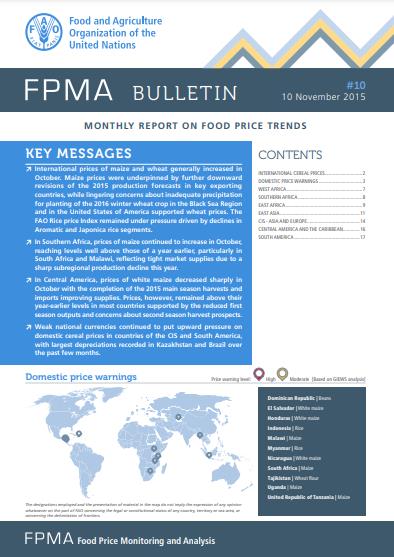
Food Price Monitoring and Analysis (FPMA) Bulletin #10, 10 November 2015
10/11/2015
International prices of maize and wheat generally increased in October. Maize prices were underpinned by further downward revisions of the 2015 production forecasts in key exporting countries, while lingering concerns about inadequate precipitation for planting of the 2016 winter wheat crop in the Black Sea Region and in the United States of America supported wheat prices. The FAO Rice price Index remained under pressure driven by declines in Aromatic and Japonica rice segments. In Southern Africa, prices of maize continued to increase in October, reaching levels well above those of a year earlier, particularly in South Africa and Malawi, reflecting tight market supplies due to a sharp subregional production decline this year. In Central America, prices of white maize decreased sharply in October with the completion of the 2015 main season harvests and imports improving supplies. Prices, however, remained above their year-earlier levels in most countries supported by the reduced first season outputs and concerns about second season harvest prospects. Weak national currencies continued to put upward pressure on domestic cereal prices in countries of the CIS and South America, with largest depreciations recorded in Kazakhstan and Brazil over the past few months.
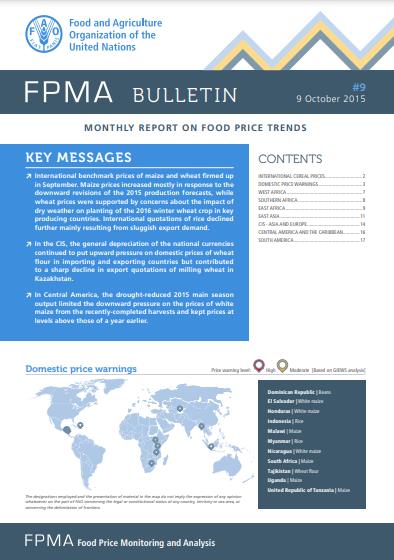
Food Price Monitoring and Analysis (FPMA) Bulletin #9, 9 October 2015
09/10/2015
International benchmark prices of maize and wheat firmed up in September. Maize prices increased mostly in response to the downward revisions of the 2015 production forecasts, while wheat prices were supported by concerns about the impact of dry weather on planting of the 2016 winter wheat crop in key producing countries. International quotations of rice declined further mainly resulting from sluggish export demand. In the CIS, the general depreciation of the national currencies continued to put upward pressure on domestic prices of wheat flour in importing and exporting countries but contributed to a sharp decline in export quotations of milling wheat in Kazakhstan. In Central America, the drought-reduced 2015 main season output limited the downward pressure on the prices of white maize from the recently-completed harvests and kept prices at levels above those of a year earlier.
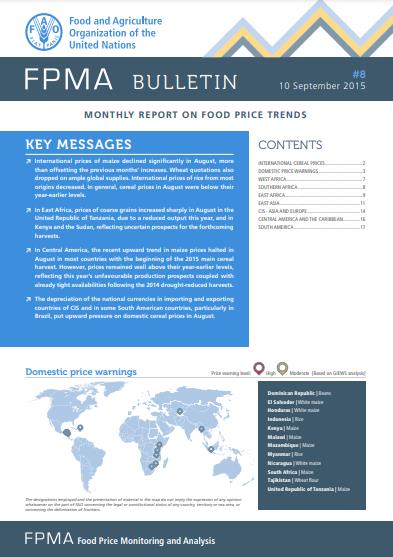
Food Price Monitoring and Analysis (FPMA) Bulletin #8, 10 September 2015
10/09/2015
International prices of maize declined significantly in August, more than offsetting the previous months’ increases. Wheat quotations also dropped on ample global supplies. International prices of rice from most origins decreased. In general, cereal prices in August were below their year‑earlier levels. In East Africa, prices of coarse grains increased sharply in August in the United Republic of Tanzania, due to a reduced output this year, and in Kenya and the Sudan, reflecting uncertain prospects for the forthcoming harvests. In Central America, the recent upward trend in maize prices halted in August in most countries with the beginning of the 2015 main cereal harvest. However, prices remained well above their year-earlier levels, reflecting this year’s unfavourable production prospects coupled with already tight availabilities following the 2014 drought-reduced harvests. The depreciation of the national currencies in importing and exporting countries of CIS and in some South American countries, particularly in Brazil, put upward pressure on domestic cereal prices in August.
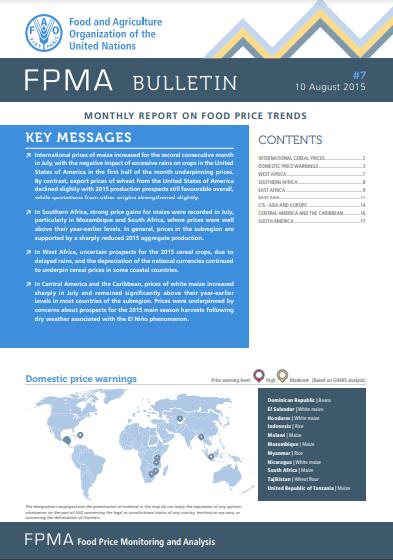
Food Price Monitoring and Analysis (FPMA) Bulletin #7, 10 August 2015
10/08/2015
International prices of maize increased for the second consecutive month in July, with the negative impact of excessive rains on crops in the United States of America in the first half of the month underpinning prices. By contrast, export prices of wheat from the United States of America declined slightly with 2015 production prospects still favourable overall, while quotations from other origins strengthened slightly. In Southern Africa, strong price gains for maize were recorded in July, particularly in Mozambique and South Africa, where prices were well above their year-earlier levels. In general, prices in the subregion are supported by a sharply reduced 2015 aggregate production. In West Africa, uncertain prospects for the 2015 cereal crops, due to delayed rains, and the depreciation of the national currencies continued to underpin cereal prices in some coastal countries. In Central America and the Caribbean, prices of white maize increased sharply in July and remained significantly above their year-earlier levels in most countries of the subregion. Prices were underpinned by concerns about prospects for the 2015 main season harvests following dry weather associated with the El Niño phenomenon.
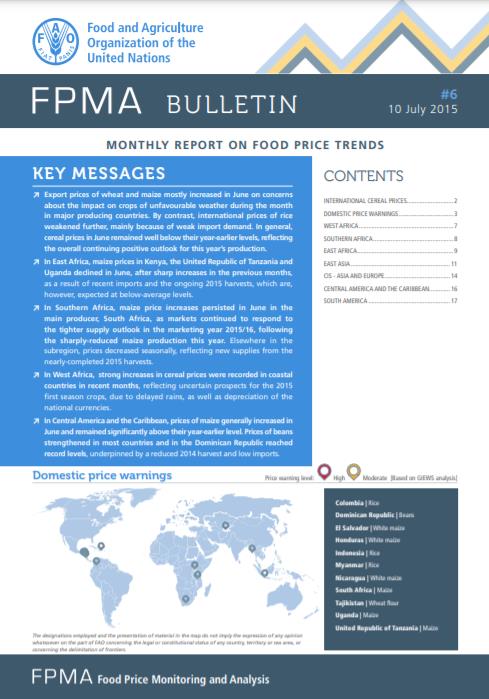
Food Price Monitoring and Analysis (FPMA) Bulletin #6, 10 July 2015
10/07/2015
Export prices of wheat and maize mostly increased in June on concerns about the impact on crops of unfavourable weather during the month in major producing countries. By contrast, international prices of rice weakened further, mainly because of weak import demand. In general, cereal prices in June remained well below their year‑earlier levels, reflecting the overall continuing positive outlook for this year’s production. In East Africa, maize prices in Kenya, the United Republic of Tanzania and Uganda declined in June, after sharp increases in the previous months, as a result of recent imports and the ongoing 2015 harvests, which are, however, expected at below‑average levels. In Southern Africa, maize price increases persisted in June in the main producer, South Africa, as markets continued to respond to the tighter supply outlook in the marketing year 2015/16, following the sharply‑reduced maize production this year. Elsewhere in the subregion, prices decreased seasonally, reflecting new supplies from the nearly‑completed 2015 harvests. In West Africa, strong increases in cereal prices were recorded in coastal countries in recent months, reflecting uncertain prospects for the 2015 first season crops, due to delayed rains, as well as depreciation of the national currencies. In Central America and the Caribbean, prices of maize generally increased in June and remained significantly above their year-earlier level. Prices of beans strengthened in most countries and in the Dominican Republic reached record levels, underpinned by a reduced 2014 harvest and low imports.
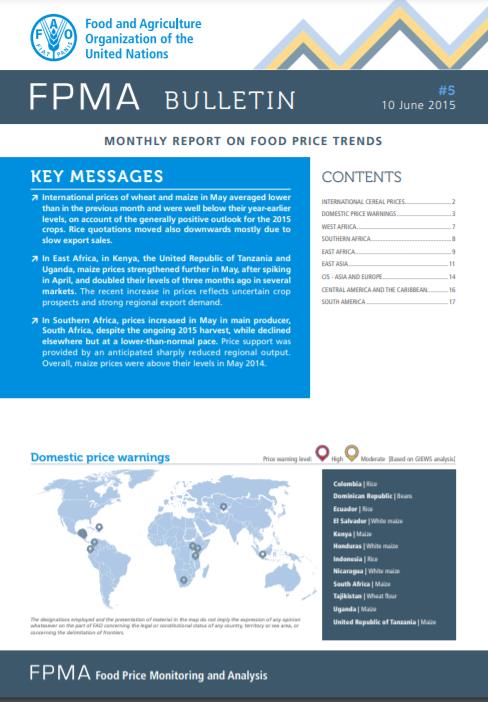
Food Price Monitoring and Analysis (FPMA) Bulletin #5, 10 June 2015
10/06/2015
International prices of wheat and maize in May averaged lower than in the previous month and were well below their year‑earlier levels, on account of the generally positive outlook for the 2015 crops. Rice quotations moved also downwards mostly due to slow export sales. In East Africa, in Kenya, the United Republic of Tanzania and Uganda, maize prices strengthened further in May, after spiking in April, and doubled their levels of three months ago in several markets. The recent increase in prices reflects uncertain crop prospects and strong regional export demand. In Southern Africa, prices increased in May in main producer, South Africa, despite the ongoing 2015 harvest, while declined elsewhere but at a lower-than-normal pace. Price support was provided by an anticipated sharply reduced regional output. Overall, maize prices were above their levels in May 2014.
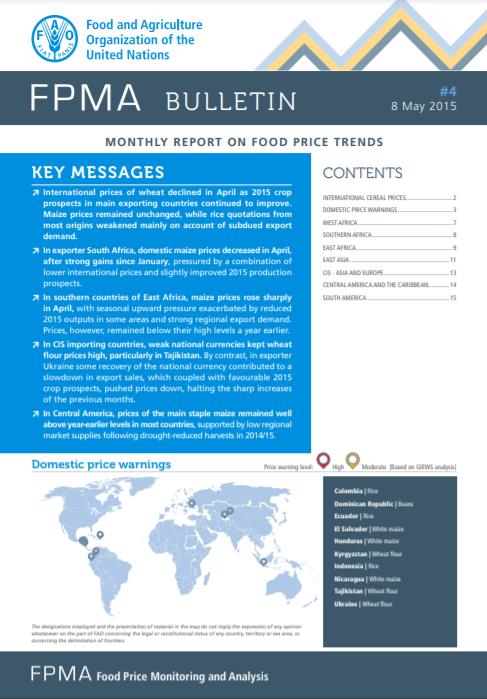
Food Price Monitoring and Analysis (FPMA) Bulletin #4, 8 May 2015
08/05/2015
International prices of wheat declined in April as 2015 crop prospects in main exporting countries continued to improve. Maize prices remained unchanged, while rice quotations from most origins weakened mainly on account of subdued export demand. In exporter South Africa, domestic maize prices decreased in April, after strong gains since January, pressured by a combination of lower international prices and slightly improved 2015 production prospects. In southern countries of East Africa, maize prices rose sharply in April, with seasonal upward pressure exacerbated by reduced 2015 outputs in some areas and strong regional export demand. Prices, however, remained below their high levels a year earlier. In CIS importing countries, weak national currencies kept wheat flour prices high, particularly in Tajikistan. By contrast, in exporter Ukraine some recovery of the national currency contributed to a slowdown in export sales, which coupled with favourable 2015 crop prospects, pushed prices down, halting the sharp increases of the previous months. In Central America, prices of the main staple maize remained well above year-earlier levels in most countries, supported by low regional market supplies following drought-reduced harvests in 2014/15.
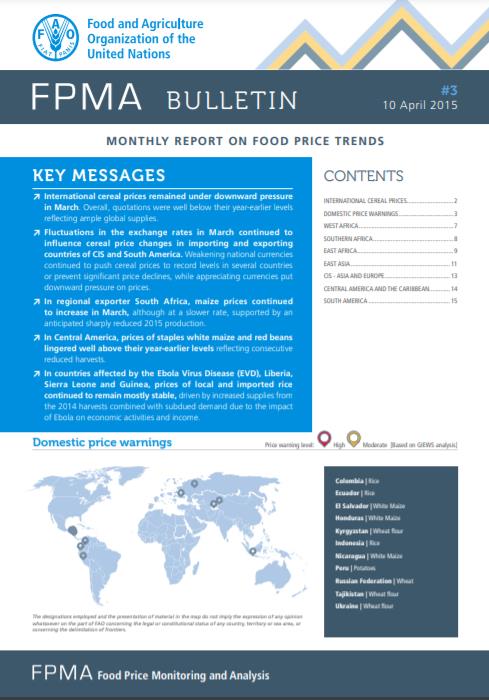
Food Price Monitoring and Analysis (FPMA) Bulletin #3, 10 April 2015
10/04/2015
International cereal prices remained under downward pressure in March. Overall, quotations were well below their year-earlier levels reflecting ample global supplies. Fluctuations in the exchange rates in March continued to influence cereal price changes in importing and exporting countries of CIS and South America. Weakening national currencies continued to push cereal prices to record levels in several countries or prevent significant price declines, while appreciating currencies put downward pressure on prices. In regional exporter South Africa, maize prices continued to increase in March, although at a slower rate, supported by an anticipated sharply reduced 2015 production. In Central America, prices of staples white maize and red beans lingered well above their year-earlier levels reflecting consecutive reduced harvests. In countries affected by the Ebola Virus Disease (EVD), Liberia, Sierra Leone and Guinea, prices of local and imported rice continued to remain mostly stable, driven by increased supplies from the 2014 harvests combined with subdued demand due to the impact of Ebola on economic activities and income.
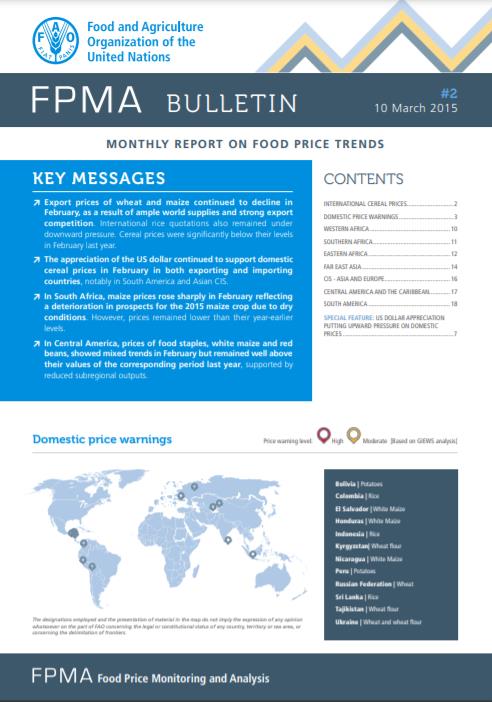
Food Price Monitoring and Analysis (FPMA) Bulletin #2, 10 March 2015
10/03/2015
Export prices of wheat and maize continued to decline in February, as a result of ample world supplies and strong export competition. International rice quotations also remained under downward pressure. Cereal prices were significantly below their levels in February last year. The appreciation of the US dollar continued to support domestic cereal prices in February in both exporting and importing countries, notably in South America and Asian CIS. In South Africa, maize prices rose sharply in February reflecting a deterioration in prospects for the 2015 maize crop due to dry conditions. However, prices remained lower than their year‑earlier levels. In Central America, prices of food staples, white maize and red beans, showed mixed trends in February but remained well above their values of the corresponding period last year, supported by reduced subregional outputs.
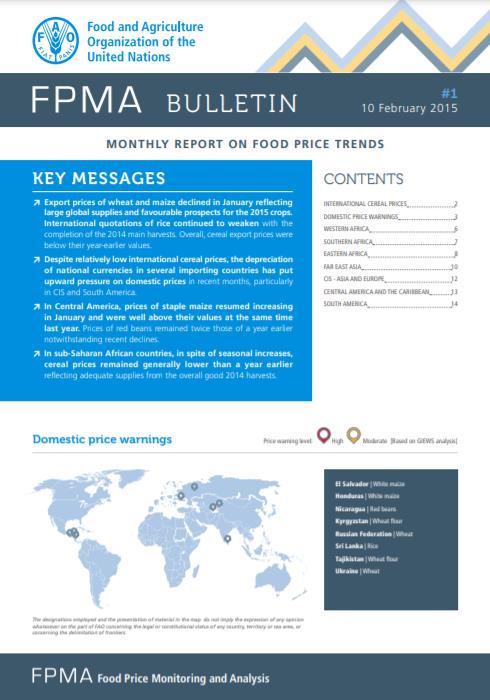
Food Price Monitoring and Analysis (FPMA) Bulletin #1, 10 February 2015
10/02/2015
Export prices of wheat and maize declined in January reflecting large global supplies and favourable prospects for the 2015 crops. International quotations of rice continued to weaken with the completion of the 2014 main harvests. Overall, cereal export prices were below their year-earlier values.
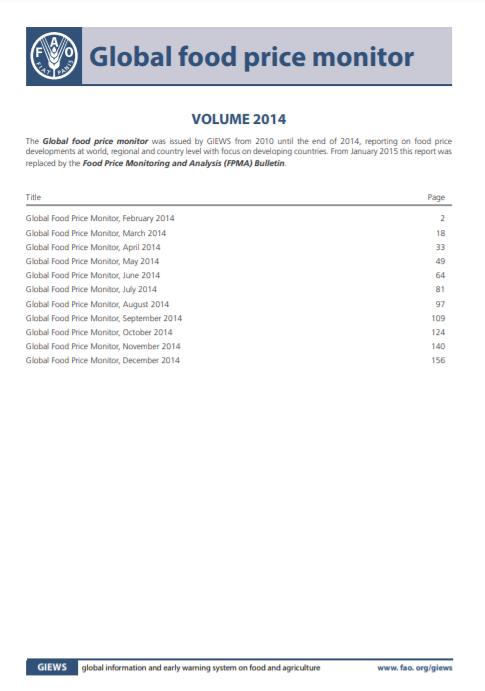
Global food price monitor - Volume 2014
11/12/2014
The Global food price monitor was issued by GIEWS from 2010 until the end of 2014, reporting on food price developments at world, regional and country level with focus on developing countries. From January 2015 this report was replaced by the Food Price Monitoring and Analysis (FPMA) Bulletin.
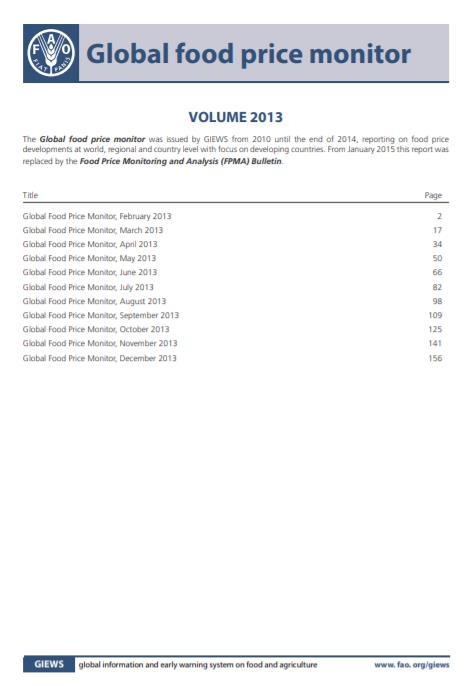
Global food price monitor - Volume 2013
05/12/2013
The Global food price monitor was issued by GIEWS from 2010 until the end of 2014, reporting on food price developments at world, regional and country level with focus on developing countries. From January 2015 this report was replaced by the Food Price Monitoring and Analysis (FPMA) Bulletin.
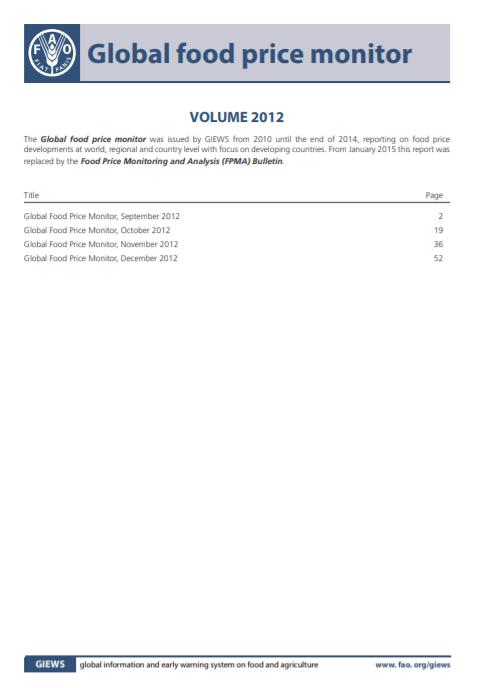
Global food price monitor - Volumke 2012
08/11/2012
The Global food price monitor was issued by GIEWS from 2010 until the end of 2014, reporting on food price developments at world, regional and country level with focus on developing countries. From January 2015 this report was replaced by the Food Price Monitoring and Analysis (FPMA) Bulletin.
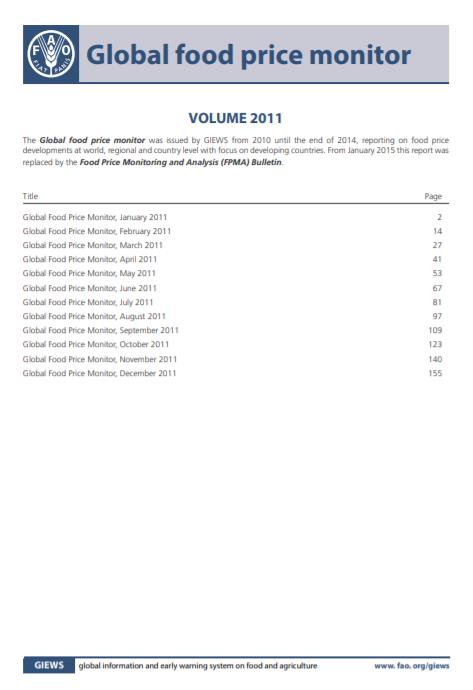
Global food price monitor - Volume 2011
08/12/2011
The Global food price monitor was issued by GIEWS from 2010 until the end of 2014, reporting on food price developments at world, regional and country level with focus on developing countries. From January 2015 this report was replaced by the Food Price Monitoring and Analysis (FPMA) Bulletin.
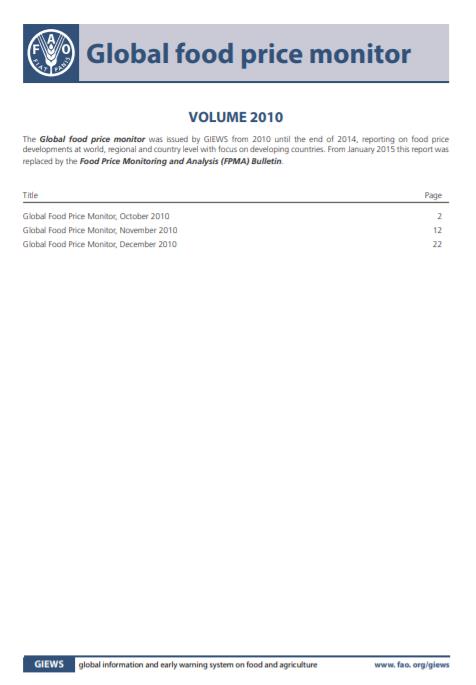
Global food price monitor - Volume 2010
09/12/2010
The Global food price monitor was issued by GIEWS from 2010 until the end of 2014, reporting on food price developments at world, regional and country level with focus on developing countries. From January 2015 this report was replaced by the Food Price Monitoring and Analysis (FPMA) Bulletin.
